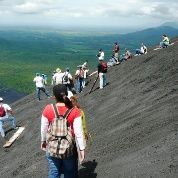Nicaragua shows that it is possible to combine tourism with development and economic growth while at the same time avoiding the negative social impact in the form of prostitution, child abuse, high crime rates, violence and environmental damage commonly associated with those activities. The secret? A holistic approach where strong social policies go hand in hand with popular participation and a conscious priority in favor of small and medium-size companies.

The total figures of tourists have more than doubled during the past 15 years, from 581,706 in 2000 to 898,699 in 2006, the year before the FSLN came to power, to 1011,251 in 2010 to 1390,338, according to official data from the Tourism Institute, INTUR. The provenance of these tourists has been fairly consistent over the years: Over 60% Central Americans; 25% North Americans; 7% Europeans and a little bit over 2% from South America. These tourists stay an average of 7.7 days in the country, spending some US$40-50 every day.
Tourism has an important economic significance for Nicaragua: Last year it generated 445 million US dollars, about 5% of the country's GDP – roughly the same level of aid coming from the ALBA-PETROCARIBE framework as well as of the income from the money Nicaraguans abroad sent their relatives in the home country. In 2014, tourism was Nicaragua's second most important source of foreign exchange earnings.
Surfing and volcano climbing have been two tourist activities that have experienced important increases in recent years, amounting to over 30% of the tourists in 2014. In fact, these and other active styles of tourism, from trekking to sand skiing to paddling to kayaking or canopying, amount to a staggering 90% of the activities tourists visiting Nicaragua choose to engage in.
In 2014, Nicaragua's colonial cities, Granada and León, attracted 21% of visitors, the beaches in the Pacific Ocean, like San Juan del Sur, over 14% and the island of Ometepe in Lake Nicaragua 6.8%, remain the most popular destinations. But many tourists visited a variety of places outside these major destinations, ranging from the country's various natural reserves and the Rio San Juan to Corn Island on the Caribbean Coast.
The amount of tourists that chose other places of interest outside the most widely known ones increased from 32.5% in 2010 to 43.3% last year. This is revealing if one takes into account that well over 80% of those tourists have a college education. Increasingly, many of them are interested in something else than just another vacation in an all-inclusive hotel, alienated from both social and natural reality.
In spite of big touristic developments such as the exclusive resort "Guacalito de la Isla" on the Pacific Coast near Tola in Rivas, much of this wave of touristic development actually taking place in Nicaragua is based on small to medium size, community initiatives. It can have to do with small, family-owned hotels in traditional tourist towns such as Granada or León, medium size cooperatively owned and managed hotels in Managua, or small and micro-businesses across the country's less well-known departments.
It can involve small foreign investors and/or NGOs, for example setting up ecolodges with cabins in Jiquilillo, Chinandega, where besides surfing, exploring the Natural Reserve of Padre Ramos and excellent, locally-grown food, visitors are offered the choice of volunteering for a few days or weeks helping the local population with after-school activities for the children while at the same time improving their Spanish. Also in Jiquilillo, another lodging facility combines surfing with hands-on studies on issues such as sustainable development and combating poverty.
The local fisher village of Jiquilillo benefits from this sort of initiative in various ways: Local youths are trained and hired as guides and/or interpreters, peasants and fishers sell their produce to the various lodgings and often find jobs there that do not interfere with the community's traditional economic activities. At the Apoyo Lake in Masaya, many local lodges offer tourists a fully equipped collective kitchen where they can prepare their meals, thus further encouraging the use of local groceries.
In Northern Nicaragua, many coffee-growers have found ways of combining the production of high-quality coffee-beans with ecolodging within the various rainforest natural reserves.
A coffee plantation within the Datanli Natural Reserve near Lake Apanas in Jinotega, combines coffee growing with a technical school for local youths who learn both agriculture and tourism in order to acquire knowledge that they can use to make a living and start small businesses on their own. The youths combine their theoretical training with practice in the fields, in the chicken farm and in the ecolodge at the plantation.
In a context of strong public policies that effectively address pressing issues such as extreme poverty, insecurity and lack of infrastructure and basic services, ecotourism alternatives make a lot of sense and can become truly sustainable.
Initiatives such as the ones described above count with the active support of both the national government, local municipal authorities and local communities. Nicaragua's Tourism Institute, INTUR, not only puts much effort into promoting the tourism sector in international travel and tourism fairs and conferences abroad, but also carries out constant campaigns of information and certification within Nicaragua.
Training programs run by universities, public institutions and local government to prepare young people in the field will develop Nicaraguan tourism further. That supportive investment in training, information and publicity has been accompanied by new infrastructure in the form of better roads, new small airports and progressive improvements in communications and electricity distribution.
In 2014 Nicaragua's legislature passed a law approving incentives for tourism in Nicaragua for a total of 47 investment projects totaling over US$87 million to diversify tourism services in the country. Tourism is likely to play an increasingly positive role in Nicaragua's economic development as the attraction of the country's great natural beauty and strong cultural traditions as well as its security and rapidly modernizing infrastructure become more widely known.